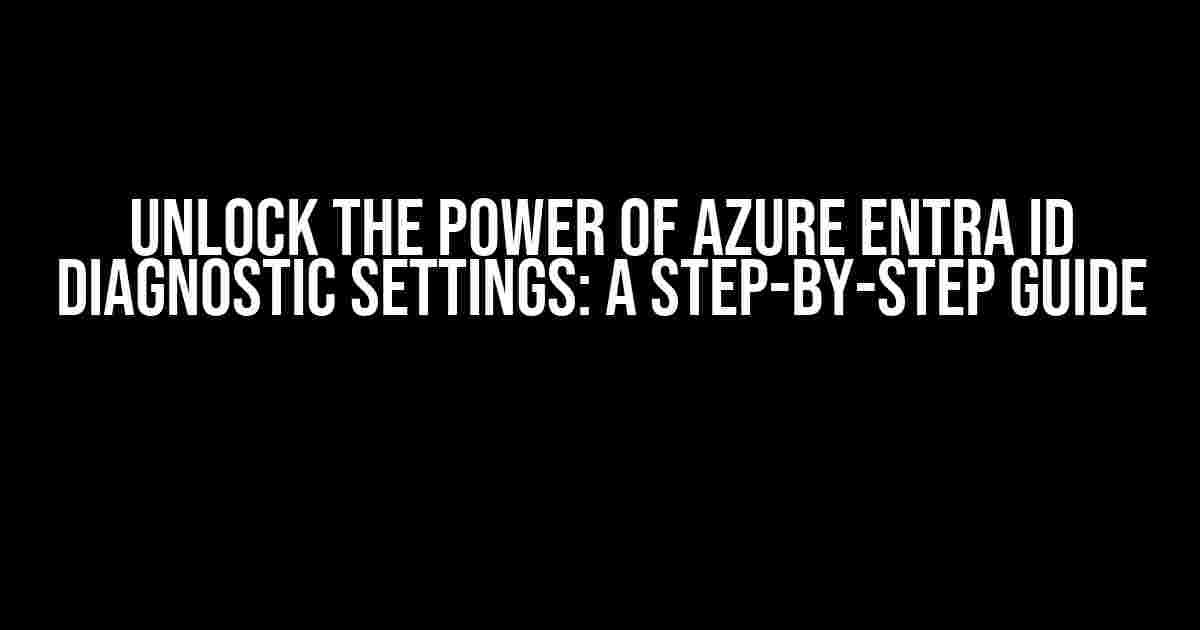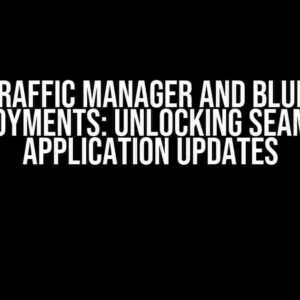Azure Entra ID is a powerful identity and access management solution that helps organizations to secure and manage their digital identities. One of the key features of Azure Entra ID is its diagnostic settings, which provide valuable insights into the system’s performance, security, and configuration. In this article, we will delve into the world of Azure Entra ID diagnostic settings and explore how to read and utilize them effectively.
What are Azure Entra ID Diagnostic Settings?
Azure Entra ID diagnostic settings are a set of configurable options that allow administrators to monitor and troubleshoot various aspects of the system. These settings provide detailed logs, performance metrics, and security insights that help administrators to identify and resolve issues, optimize system performance, and improve overall security posture.
Types of Diagnostic Settings
Azure Entra ID offers several types of diagnostic settings, including:
Log Analytics: Collects and analyzes log data to provide insights into system performance, security, and user activity.Metrics: Tracks performance metrics, such as latency, throughput, and error rates, to help administrators optimize system performance.Diagnostic Logs: Provides detailed logs of system events, errors, and warnings to help administrators troubleshoot issues.Audit Logs: Tracks administrative actions, such as configuration changes and user access, to provide a complete audit trail.
How to Configure Azure Entra ID Diagnostic Settings
Configuring Azure Entra ID diagnostic settings is a straightforward process that requires minimal technical expertise. Here’s a step-by-step guide to get you started:
-
Sign in to Azure Entra ID: Log in to the Azure Entra ID portal using your administrative credentials. -
Navigate to Diagnostic Settings: Click on theDiagnostic settingstab located in the left-hand menu. -
Choose the Diagnostic Setting Type: Select the type of diagnostic setting you want to configure, such asLog AnalyticsorMetrics. -
Configure the Diagnostic Setting: Follow the on-screen instructions to configure the diagnostic setting, such as specifying the log level, data retention period, and storage location.
Best Practices for Configuring Diagnostic Settings
To get the most out of Azure Entra ID diagnostic settings, follow these best practices:
-
Enable Diagnostic Settings for Critical Resources: Configure diagnostic settings for critical resources, such as authentication and authorization, to ensure timely detection of issues. -
Set Appropriate Log Levels: Set log levels according to your organizational requirements to avoid information overload and ensure relevant data is captured. -
Configure Data Retention Periods: Set data retention periods based on your organization’s compliance requirements and storage constraints. -
Monitor Diagnostic Settings Regularly: Regularly review diagnostic settings to ensure they are configured correctly and providing valuable insights.
How to Read and Analyze Azure Entra ID Diagnostic Settings
Once you’ve configured Azure Entra ID diagnostic settings, it’s essential to know how to read and analyze the data they provide. Here are some tips to get you started:
Log Analytics
Log Analytics provides detailed insights into system performance, security, and user activity. To analyze Log Analytics data:
-
Navigate to Log Analytics: Click on theLog Analyticstab located in the left-hand menu. -
Choose the Log Level: Select the log level you want to analyze, such asINFO,WARNING, orERROR. -
Filter and Search Logs: Use the filtering and search capabilities to narrow down the logs based on specific criteria, such as date, time, and event type.
Filter:
EventID == 4624
AND
EventLevel == WARNING
AND
Timestamp >= ago(1h)
This filter searches for WARNING-level logs with EventID 4624 that occurred within the last hour.
Metrics
Metric data provides insights into system performance and usage patterns. To analyze metrics data:
-
Navigate to Metrics: Click on theMetricstab located in the left-hand menu. -
Choose the Metric: Select the metric you want to analyze, such asSignInFailedorAverageResponseTime. -
Configure the Time Range: Set the time range for which you want to analyze the metric data.
| Metric | Description | Units |
|---|---|---|
| SignInFailed | Number of failed sign-in attempts | Count |
| AverageResponseTime | Average response time for authentication requests | Milliseconds |
Diagnostic Logs
Diagnostic logs provide detailed information about system events, errors, and warnings. To analyze diagnostic logs:
-
Navigate to Diagnostic Logs: Click on theDiagnostic Logstab located in the left-hand menu. -
Choose the Log Level: Select the log level you want to analyze, such asINFO,WARNING, orERROR. -
Filter and Search Logs: Use the filtering and search capabilities to narrow down the logs based on specific criteria, such as date, time, and event type.
Filter:
EventID == 1500
AND
EventLevel == ERROR
AND
Timestamp >= ago(1h)
This filter searches for ERROR-level logs with EventID 1500 that occurred within the last hour.
Common Scenarios and Troubleshooting
In this section, we’ll explore common scenarios and troubleshooting techniques using Azure Entra ID diagnostic settings:
Scenario 1: Investigating Sign-in Issues
If users are experiencing sign-in issues, you can use Log Analytics to investigate the cause:
-
Search for Sign-in Related Logs: Use the filtering and search capabilities to search for logs related to sign-in attempts, such as EventID 4624. -
Analyze Log Data: Analyze the log data to identify patterns, such as failed sign-in attempts, authentication errors, or unexpected latency. -
Configure Additional Diagnostic Settings: Configure additional diagnostic settings, such as Metrics or Diagnostic Logs, to gather more detailed information.
Scenario 2: Optimizing System Performance
If you’re experiencing performance issues, you can use Metrics to identify bottlenecks and optimize system performance:
-
Monitor Performance Metrics: Monitor performance metrics, such as AverageResponseTime, to identify performance bottlenecks. -
Analyze Metric Data: Analyze metric data to identify patterns, such as spikes in latency or throughput. -
Optimize System Configuration: Optimize system configuration, such as scaling up or out, to improve performance.
Conclusion
Azure Entra ID diagnostic settings provide a powerful toolset for optimizing system performance, improving security, and troubleshooting issues. By following the best practices outlined in this article, you can unlock the full potential of Azure Entra ID diagnostic settings and take your identity and access management to the next level.
Remember to regularly review and analyze diagnostic settings to ensure you’re getting the most out of your Azure Entra ID investment.
Frequently Asked Questions
Get ready to dive into the world of Azure Entra ID Diagnostic Settings! Here are the top 5 questions you’ve been wondering about, answered:
What are Azure Entra ID Diagnostic Settings, and why do I need them?
Azure Entra ID Diagnostic Settings are a set of advanced settings that help you troubleshoot and resolve identity-related issues in your Azure AD environment. You need them to gain visibility into authentication and authorization processes, identify potential security risks, and improve the overall user experience.
How do I access Azure Entra ID Diagnostic Settings?
To access Azure Entra ID Diagnostic Settings, navigate to the Azure portal, click on “Azure Active Directory” in the top navigation menu, and then select “Diagnostic settings” from the left-hand menu. Make sure you have the necessary permissions and role assignments to access these settings.
What types of diagnostic data can I collect with Azure Entra ID Diagnostic Settings?
With Azure Entra ID Diagnostic Settings, you can collect a wide range of diagnostic data, including authentication request and response data, token validation data, and Azure AD B2C-specific data. You can also collect data from other Azure services, such as Azure AD Domain Services and Azure AD Connect.
Can I customize the diagnostic data collection process in Azure Entra ID Diagnostic Settings?
Yes, you can customize the diagnostic data collection process in Azure Entra ID Diagnostic Settings. You can choose which data types to collect, set up filters and event types, and even schedule data collection to run at specific times or intervals.
How do I analyze and interpret the diagnostic data collected with Azure Entra ID Diagnostic Settings?
To analyze and interpret the diagnostic data collected with Azure Entra ID Diagnostic Settings, you can use various tools and techniques, such as Azure Log Analytics, Azure Monitor, and Azure Storage Explorer. You can also use Azure Entra ID’s built-in analytics and reporting features to gain insights into your identity-related data.



